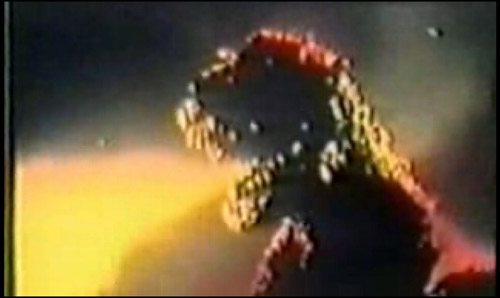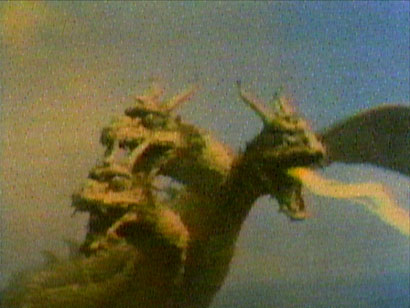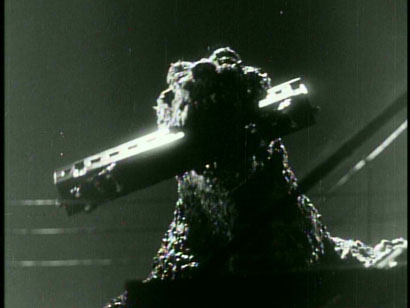Cozzilla
aka Godzilla, il re dei mostri

1977![]()

Italian rearrangement and direction by Luigi Cozzi

Godzilla, il re dei mostri (hence after known as Cozzilla) began life long ago as 1954’s Gojira. After becoming a box office hit in Japan, the film was recut for America with scenes added starring Raymond Burr (at that time relatively unknown.) Godzilla, King of the Monsters proved to be a hit in America as well. Sequels were spawned, a franchise was born, and new Godzilla films were being produced 50 years later. The US cut of Gojira is not the only overseas modified version. Another one has gained some fame for the many odd alterations done to it. Writer/director Luigi Cozzi is a big fan of Godzilla, wrote a book about Big G, and is even nicknamed Cozzilla by his friends. Cozzi is best known here for being the director/Writer of Star Crash, Contamination, and the Lou Ferrigno Hercules movies, as well as the writer of Devil Fish (featured on MST3K.) None of those films are known for their stellar plots or special effects, but instead their cheese and terribleness. Here, one finds that even with a great movie base to work off of, you can ruin a final product.
Cozzi set out to share with Italy the great monster film, but he knew he would have to alter it for Italian audiences. In 1977, no one went to black and white films, thus Cozzi set up an elaborate colorization process known as Spectrorama 70. Colored gels were set behind frames of the film, oversaw by Armando Valcauda. New music cues were put together by Alberto Moro to go with the altered length of the film. Scenes were chopped out, and much new footage was added, but mostly World War II stock shots of bombed cities, weapons firing, and dead bodies. Yes, actual dead bodies. Also, a shark fights an octopus from The Beast from 20,000 Fathoms towards the end.
The only known copy of this film is a VHS tape that had direct footage from a 16mm print (complete with reel announces.) As the tape was old, parts of it are choppy, and it appears to cut off abruptly at the end. wtfFILM got a hold of a copy of the tape and helped allow the world to see it, first by providing DVDRs and then uploading the film to Google Video. You can see the film here with their review. Some of the background information mentioned here was revealed there, and they even subtitled the movie themselves! As of this writing the store is closed, but hopefully it will be open soon, he has some other neat stuff around (including a trailer I saw for a restored version of Cozilla, which looks like it might be re-color-altered from Godzilla KOTM DVDs! Maybe that will get compelted soon and we can have a real treat!)

Godzilla has always been an allegory about the dangers of the atomic bomb, even when he was dashing out of a cave to save TV hero Zone Fighter (okay, maybe not then) but this version of the film takes that to an extreme level. It is so extreme, I was expecting the film to be chugging Mt. Dew and snowboarding out of airplanes into a volcano. It is a depressing kind of extreme, as Godzilla turns into an indictment of war and the human race in general. Thanks to the ample WW2 stock footage, we see far too many real dead bodies for anyone’s taste. Sure, the original film was about the horrors of the atomic bomb, but they didn’t make you want to go curl up in a hole and cry. Talk about brushing your teeth with a shotgun! Thankfully, the VHS quality and the Spectorama 70 color bleed takes the wind out of the sails on some of the images’ graphic details.
The overall use of the color does some nice work setting the atmosphere of the film at times. Godzilla’s attack and the Tokyo destruction are shown as bright red, and makes it violent, chaotic, and tragic at the same time. I enjoyed that choice of color, but at other times the random blues, greens, and yellows seemed to be chosen haphazardly. Some of the screenshots will just look odd because of that. I tried to make many of the shots identical to the ones in the Godzilla, King of the Monsters review, so you can flip between them and see how the color made them different (ignoring the obvious difference in video quality.) In addition, I threw in new shots of the older altered movie and the new inserted footage. As we go along the plot, I’ll point out what differs, and copy over some of the similarities, as the basic story is the same.





















